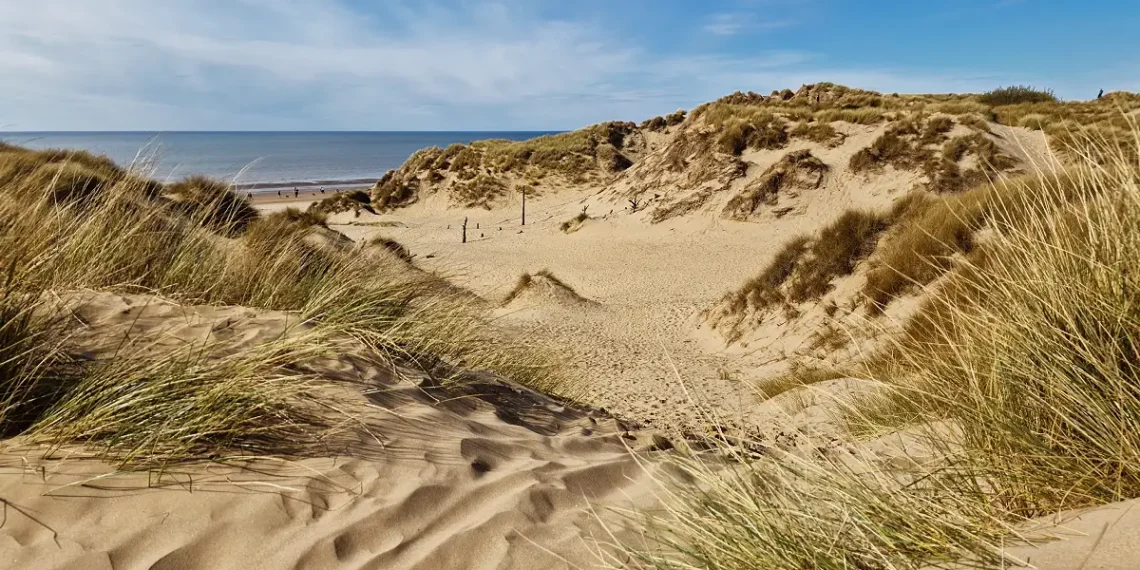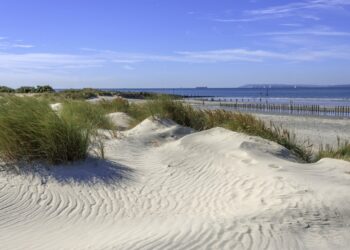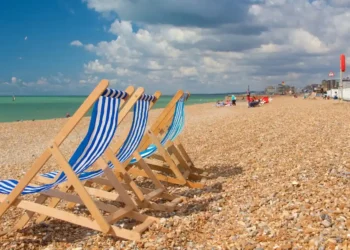Formby Beach sits on the Sefton Coast in Merseyside, England. It has long stretches of sand, large sand dunes, and lots of wildlife. The 500-acre area is cared for by the National Trust and is part of the Liverpool Bay coastline, about 12 miles north of Liverpool city. Famous for its natural beauty and rare animals like natterjack toads, the beach is often visited by people for walks, to watch wildlife or even for family outings. Being part of a Site of Special Scientific Interest (SSSI) shows it’s an important spot for nature.
Fun Fact About Formby Beach
Formby Beach has one of the biggest groups of natterjack toads in the UK. These protected toads are easy to spot because of the yellow stripe running along their backs. In spring, you can hear their unique croaking at dusk, especially in the shallow pools among the sand dunes where they lay their eggs.
History of Formby Beach
Formby Beach’s story is closely linked with the Sefton Coast and the village of Formby, which goes back to Anglo-Saxon times. The name “Formby” comes from Old Norse, meaning “village of Forni,” showing Viking influence around the 9th century. Long ago, people in the area did small-scale farming and fishing, while the wind and tides shaped the sand dunes that still define the coastline today.
In the 1800s, Formby’s coast became popular with wealthy Liverpool residents, who built large homes nearby. The beach itself stayed mostly natural, keeping its unspoiled character. Archaeologists have found prehistoric footprints in the sand, more than 4,000 years old, probably left by hunter-gatherers along the ancient shoreline. These prints sometimes appear at low tide and attract both historians and visitors.
During the 1900s, conservation became important. The National Trust bought parts of the coast in 1967 to protect the dunes, pine woods, and wildlife. The Sefton Coast, including Formby Beach, was made a Site of Special Scientific Interest (SSSI) for its rare animals like natterjack toads and sand lizards. The area also has traces from World War II, such as old coastal defenses in the dunes.
Things to Do at Formby Beach
Formby Beach is quite a nice place if you like nature and being outside. You can walk, see animals or just enjoy the quiet surroundings. Here’s some ideas:
Walks Along the Coast: There are long trails, like the Sefton Coastal Path, which goes 21 miles from Crosby to Southport. Shorter walks, like the Asparagus Trail, show little bits of history, for example how people grew asparagus in the 1800s. Walking in the dunes, you might see the Irish Sea and even Welsh hills on a clear day.
Wildlife Watching: The dunes and pinewoods have quite varied list of unique animals like natterjack toads, red squirrels and migratory birds like oystercatchers. Sometimes the National Trust does even guided walks in spring and autumn to explain about the wildlife.
Beach Fun: The wide sandy beach is good for picnics, flying kites, and building sandcastles. At low tide, the shallow water is okay for paddling, but be careful because there are no lifeguards and the currents can be strong.
Old Footprints: Sometimes, at low tide, very old human and animal footprints appear in the mud. Guided tours explain these, but whether you see them depends on tides and weather.
Photography and Quiet Time: The dunes and pinewoods give nice spots for taking pictures, especially around sunset. You can also sit and sketch or just enjoy the calm.
Cycling: You can’t ride bikes on the beach itself, but nearby paths, like from Victoria Road car park, connect to longer routes along the coast for a nice ride.
Nearby Places: The town of Formby has some cafes and pubs, like The Pinewoods. About 6 miles south is Crosby Beach, where Anthony Gormley’s Another Place has 100 iron statues looking out to sea. You can get there by car or walking along the coast.
Best Time to Visit Formby Beach
April to June
Springtime is mild, around 8°C to 15°C, with flowers blooming and wildlife, like natterjack toads, being active. Trails are mostly dry, making it good for walks and taking photos. Crowds are not too big.
July to August
Summer is warmer, about 15°C to 20°C, good for paddling and beach fun. The dunes give some shade, but parking can fill up fast. Weekends are busy, so midweek trips are calmer.
September to October
Autumn stays cool, 10°C to 16°C, with fewer people. Dune colors look nice, and migratory birds make wildlife watching interesting. At low tide, you might see prehistoric footprints.
November to March
Winter is chilly, 4°C to 9°C, offering quiet beaches and dramatic views. Dunes can get slippery from rain. For indoor options, Formby village or Liverpool has attractions. Car parks are open, but some facilities may be closed.
Travel Tips
Check Tide Times: The sea has strong currents, so look at tide tables before going. Low tide is the best for seeing footprints and getting more sandy space.
Follow Conservation Rules: Dogs are strictly not allowed in dune areas April to September in order to protect wildlife. Use bins and stay on paths to avoid harming the dunes.
Bring Your Own: Victoria Road car park has toilets and a small kiosk, but no proper cafes. Take water, snacks, and sunscreen (SPF 30+), because there’s little shade on open sand.
Arrive Early for Parking: Car parks hold about 400 cars, so get there before 10 am in summer. National Trust members park free, so membership helps if visiting often.










